


Very high oxidation states with persulfate
This experiment shows the exceedingly strong oxidizing power of the persulfate ion. Silver can be oxidized to the +3 oxidation state and nickel can be oxidized to the +4 oxidation state. These oxidation states are really remarkable for silver and nickel, which normally exist in the +1 and +2 oxidation states.
![]()
![]() Required
chemicals:
Required
chemicals:
-
sodium persulfate (the ammonium and potassium salts also work)
- nickel sulfate (nickel nitrate is suitable as well)
- sodium hydroxide
- silver nitrate (silver oxide also is OK)
- dilute nitric acid
![]() Required
equipment:
Required
equipment:
-
test tubes
![]() Safety:
Safety:
- Persulfates are very strong oxidizers. They react somewhat sluggish, but if they are allowed to be in contact for a sufficiently long time, then they eat almost everything.
- Nickel sulfate is toxic and nickel (II) salts are believed to be carcinogens.
- Sodium hydroxide is very caustic. Be careful not to get any of this on your skin or your eyes. Eyes are damaged permanently almost instantly! If some of this is spilled on your skin, then rinse with water, until the slippery feeling has disappeared completely.
- Dilute nitric acid is corrosive.
![]() Disposal:
Disposal:
- Both nickel salts and silver salts should be disposed of properly. These metals and their salts should not be flushed down the drain.
![]()
Oxidation of nickel to its +4 oxidation state.
![]() Prepare
a solution of nickel sulfate or nickel nitrate and add a dilute solution of
sodium hydroxide to this. This results in formation of a light green flocculent
precipitate of nickel (II) hydroxide.
Prepare
a solution of nickel sulfate or nickel nitrate and add a dilute solution of
sodium hydroxide to this. This results in formation of a light green flocculent
precipitate of nickel (II) hydroxide.
![]() Add a
small amount of solid sodium persulfate to the liquid with the green
precipitate. This results in immediate formation of a black compound. The nickel
hydroxide is oxidized by the persulfate to black hydrous nickel (IV) oxide.
Add a
small amount of solid sodium persulfate to the liquid with the green
precipitate. This results in immediate formation of a black compound. The nickel
hydroxide is oxidized by the persulfate to black hydrous nickel (IV) oxide.
The two pictures below show the test tube with nickel hydroxide, the left one immediately after some solid sodium persulfate is added, and the right one after some shaking.
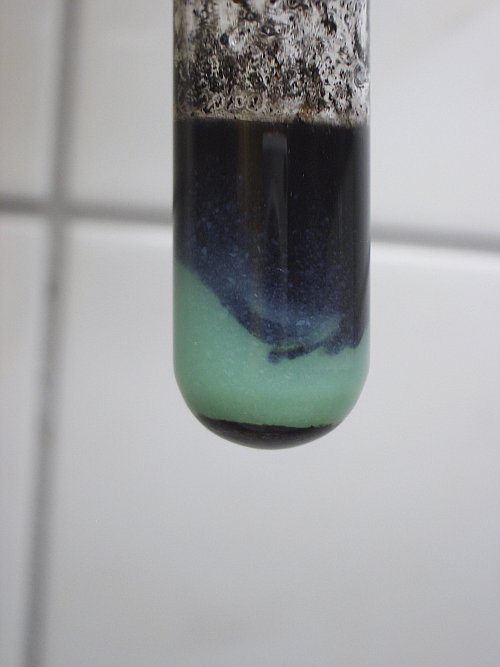
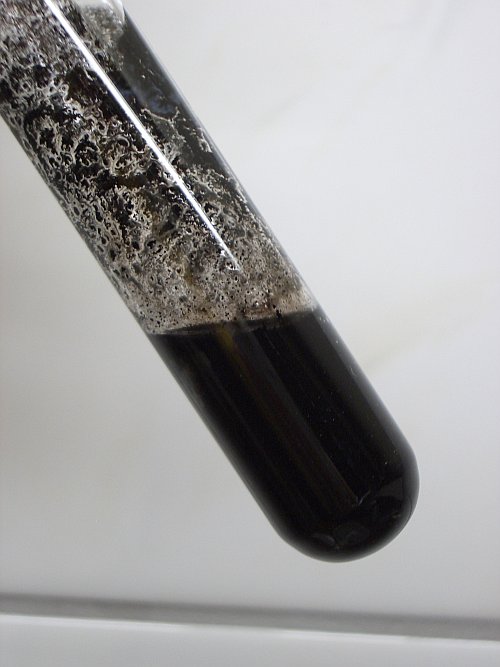
![]() Add some excess amount of dilute nitric acid to the liquid
with the black precipitate. The black solid slowly dissolves and some gas is
evolved. This gas is oxygen. The following large picture nicely shows the gas
evolved and the final remnants of very small black particles. The liquid is
light green, due to the color of fairly dilute aqueous nickel (II) ions.
Add some excess amount of dilute nitric acid to the liquid
with the black precipitate. The black solid slowly dissolves and some gas is
evolved. This gas is oxygen. The following large picture nicely shows the gas
evolved and the final remnants of very small black particles. The liquid is
light green, due to the color of fairly dilute aqueous nickel (II) ions.
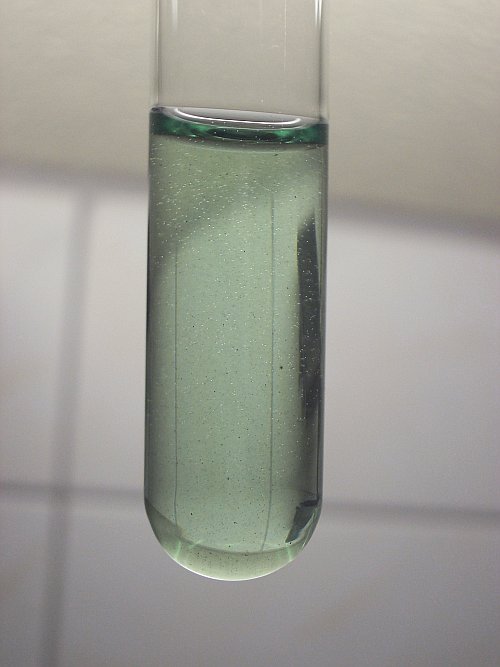
![]()
Oxidation of silver to its +3 oxidation state.
![]() Prepare a solution of silver nitrate or silver oxide in
dilute nitric acid. Any concentration of 1 to 2 mol/l for the nitric acid is OK.
Prepare a solution of silver nitrate or silver oxide in
dilute nitric acid. Any concentration of 1 to 2 mol/l for the nitric acid is OK.
![]() Add some solid sodium persulfate to the liquid. Adding a
fairly concentrated solution of sodium persulfate also works. When this is done,
then the liquid becomes brown and remains clear. The brown color is due to
silver (III) ions. The brown color is formed quickly, although not
instantaneously. It takes a few seconds.
Add some solid sodium persulfate to the liquid. Adding a
fairly concentrated solution of sodium persulfate also works. When this is done,
then the liquid becomes brown and remains clear. The brown color is due to
silver (III) ions. The brown color is formed quickly, although not
instantaneously. It takes a few seconds.
The two pictures below show the brown liquid and a small quantity of this liquid, diluted in some dilute nitric acid. These picture clearly show the brown color of silver (III) ions (*). (*) see remark below.
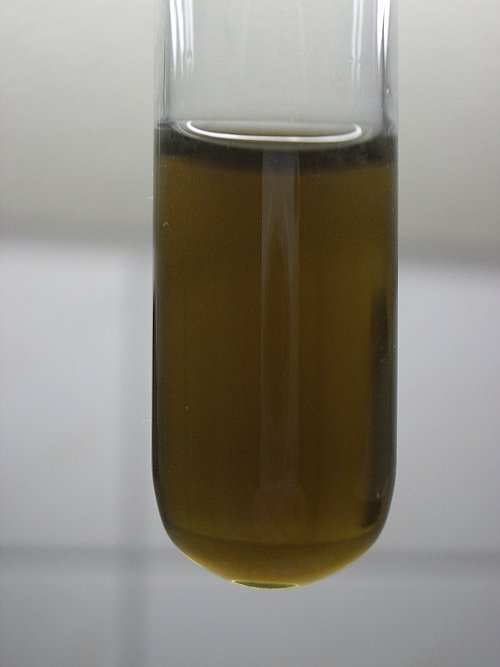
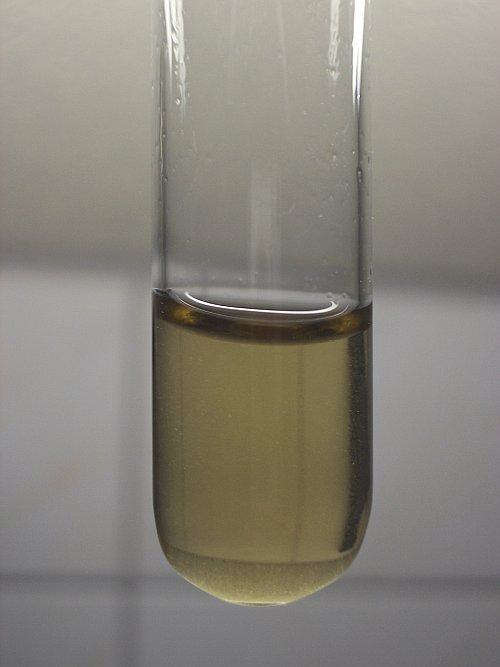
Silver (III) ions are not very stable. Even in the fairly strongly acidic liquids, the compound slowly decomposes. A black precipitate is formed and oxygen is released very slowly. This black precipitate is due to combined hydrolysis and reduction of the silver (III) ions. A mixed silver (I) silver (III) oxide is formed, which precipitates from the liquid as a black solid.
Remarkably, when persulfate is added to a neutral solution of silver nitrate, then no brown color is formed. In that case the liquid first remains colorless, but in the course of a few minutes it slowly turns turbid and a dark brown/black precipitate is formed. Apparently, at higher pH, the brown silver (III) ion is not formed at all and the mixed silver (I) silver (III) oxide is formed immediately.
Addition of sodium hydroxide, quick formation of Ag(I)Ag(III)O2
When the brown liquid is added to a solution of sodium hydroxide, then the process of formation of the black silver (I) silver (III) oxide is almost immediate. As soon as the brown liquid is added to a solution of sodium hydroxide, a dark brown very finely divided precipitate is formed. The solid particles stick together quickly and larger black particles are formed. The black solid slowly evolves oxygen and every few minutes it moves to the surface, due to many small bubbles of oxygen, which are trapped inside the precipitate. When these small bubbles of oxygen are lost, then the solid mass sinks to the bottom again. This 'dance' is repeated several times.
The three pictures below show the liquid, immediately after adding it to a slight excess amount of a solution of NaOH. The second picture shows the same liquid a few minutes later, when the particles of the precipitate stick to each other. The final picture shows the precipitate near the surface, due to lots of trapped bubbles of oxygen. All the pictures clearly show the bubbles of oxygen.
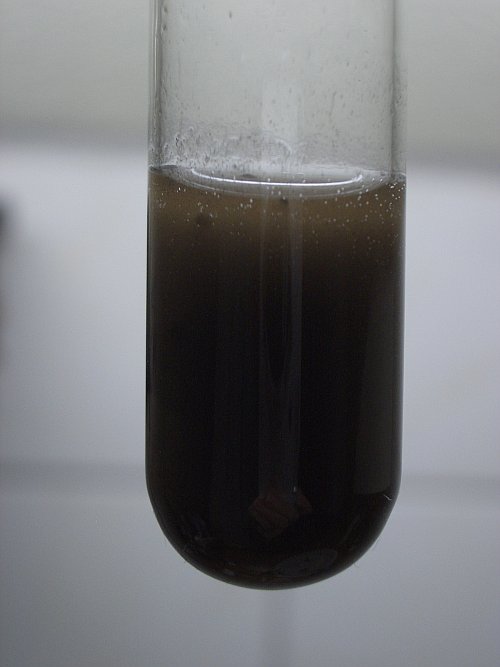
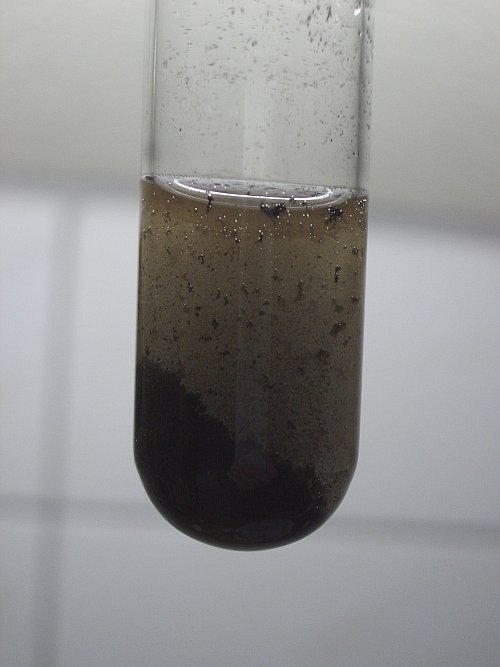
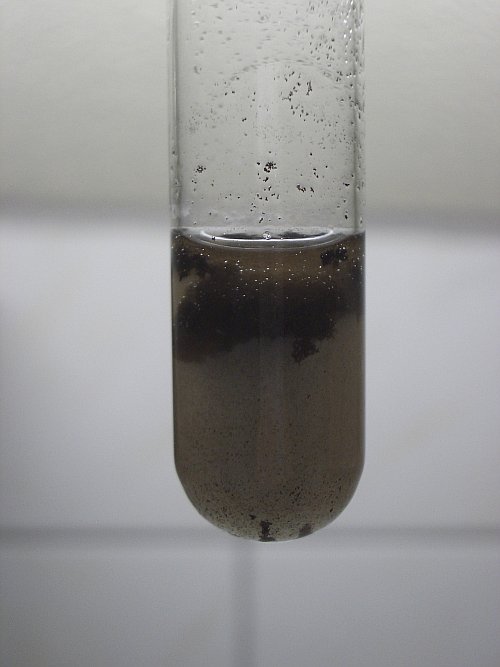
![]()
Discussion of the results
Here, the reactions with nickel (II) and silver (I) are covered separately.
Reaction with nickel
Persulfate oxidizes nickel hydroxide to nickel (IV) oxide in water.
Ni(OH)2 + 2OH– + S2O82- → NiO2 + 2SO42- + 2H2O
In the wet environment, the compound NiO2 does not exist as such, as suggested by the simplified equation, given above. In fact a non-stoichiometric compound, which can best be described as NiO2.nH2O is formed, with n some indeterminate number.
On acidification with nitric acid or sulphuric acid, the nickel (IV) compound decomposes again:
2NiO2.nH2O(s) + 4H+(aq) → 2Ni2+(aq) + O2(g) + 2H2O + nH2O
When dilute hydrochloric acid is added, then the liquid gives a strong smell of chlorine. In that case, the chloride ion is oxidized to chlorine. The liquid still bubbles in that case. Probably there will be oxidation of chloride to chlorine and still the decomposition reaction, as described above.
Reaction with silver
In acidic media, persulfate is capable of oxidizing silver (I) ions to silver (III) ions. These silver (III) ions are brown.
Ag+(aq) + S2O82-(aq) → Ag3+(aq) + 2SO42-(aq)
Silver (III) ions are not very stable. This liquid slowly looses its color and gives off oxygen. A black precipitate is formed of silver (I) silver (III) oxide. The silver (III) ions slowly oxidize the water, in which they are dissolved.
4Ag3+ + 6H2O → 2AgIAgIIIO2 + 12H+ + O2
When the liquid is made more basic, then the reaction proceeds much faster, as the experiment demonstrates. The following reaction occurs in that case.
4Ag3+ + 12OH– → 2AgIAgIIIO2 + 6H2O + O2
The compound AgAgO2 in turn also decomposes. It slowly looses oxygen and is converted to simple silver (I) oxide.
2AgIAgIIIO2 → 2AgI2O + O2
(*) Remark: Whether the brown color is due to plain Ag3+ or due to some mixed valency complex of silver (I) and silver (III) is not clear to me. It might be that the brown color is due to a mixed valency complex of silver (I) and silver (III). Examples of mixed valency complexes are also given on the following pages: copper (I) / copper (II) and titanium (III) / titanium (IV).
General remarks
Both the silver (III) compounds and the NiO2 compound are very strong oxidizers. Both compounds are capable of oxidizing manganese (IV) and manganese (II) to the +7 oxidation state as permanganate and chromium (III) is oxidized to the +6 oxidation state as dichromate or chromate.
Silver nitrate is a catalyst in many reactions with persulfate in acidic media. Persulfate is a strong oxidizer, but it also is somewhat sluggish. The reaction between silver (I) and persulfate in acidic media, however is quite fast. Silver (III) in turn reacts with manganese (II) or chromium (III) quickly to form permanganate or dichromate, itself being converted to silver (I) again. So, in the presence of a small amount of silver nitrate, the persulfate anion can be used as a fast and very strong oxidizer. The catalytic action of silver is based on the fact that an other pathway for the final redox reaction is provided, with Ag3+ as intermediate species.
A similar catalytic action can be observed with nickel hydroxide in basic solutions. The reaction between nickel hydroxide and persulfate is very fast (instantaneously, at least in terms of human observation). Nickel (IV) oxide in turn is capable of oxidizing e.g. manganese (IV) oxide to permanganate. This property can be used as a sensitive method for detecting manganese.
Another important remark is that in both experiments, the presence of chloride ions should be avoided. Especially with the silver experiment, chloride ions are really disturbing. They make the liquid cloudy, due to formation of silver (I) chloride and they interfere, due to oxidation to chlorine.
For the nickel experiment the presence of chloride is not of a direct concern, but if one wants to use NiO2 for detection of manganese by conversion to the deep purple permanganate, then even small amounts of chloride interfere and make the detection fail.
More info on the interesting and remarkable subject of silver (III) chemistry can be found in the following book: Chemistry of the Elements, second edition, written by Greenwood and Earnshaw, pages 1181 and 1188.